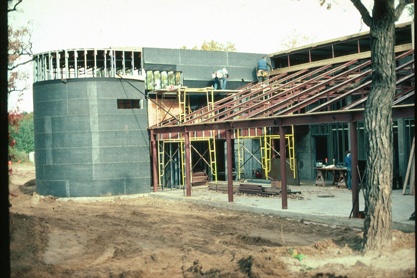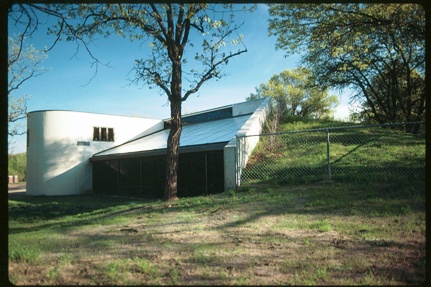

The Springbrook Nature Center has dramatically changed in the past 50 years - from undeveloped natural land, to a City Park, and finally to a popular destination for families/residents/business employees, and a regional resource for schools and volunteers.
In a typical year, Springbrook Nature Center will have about 200,000 visitors and will provide about 700 programs. The process of how Springbrook has grown and changed involves many individuals, public and private groups, land development, and even natural disasters.
Springbrook's original 124 acres were purchased by the City of Fridley in 1970/1, using Land and Water Conservation Funds from federal grants. In 1974, it was designated a Nature Center. In earlier years, Springbrook's land had been used for dairy cattle pasture, as horse riding trails, and as a roofing contractor's materials dump site. At the time it became a nature center, Springbrook was surrounded by undeveloped land and had a small 10-car dirt parking lot for the center's estimated 5,000 annual visitations.
Three acres in the southwest corner were added in 1981 when the Northern States Power Company compensated for park area placed in an easement for its new high tension power line alongside its existing line on Springbrook's west boundary. This brought the Nature Center to its current size of 127 acres.
Since 1974, Springbrook Nature Center has received more than 3.8 million dollars in grants and donations. These funds, along with Springbrook's small staff and more than 250,000 volunteer hours, have helped develop an interpretive building and exhibits, three miles of hiking trails, half mile of boardwalk over wetlands, a paved handicap accessible trail, a 90-car parking lot, picnic shelter, amphitheater, bridges, wildlife overlooks and much more.
 In 1986, a famously photographed tornado spent 16 minutes in the Nature Center, bringing national attention to Springbrook. It took years to clean up the loss of thousands of century old trees and extensive areas of mature forest habitat. The natural areas are still recovering, and evidence of the tornado can still be seen throughout the park.
In 1986, a famously photographed tornado spent 16 minutes in the Nature Center, bringing national attention to Springbrook. It took years to clean up the loss of thousands of century old trees and extensive areas of mature forest habitat. The natural areas are still recovering, and evidence of the tornado can still be seen throughout the park.
During the late eighties and nineties, the land around the Nature Center was intensely developed for residential, commercial and industrial uses. Today, Springbrook is an island of nature with annual use rising sharply. Increased development and park use causes unsustainable impacts on Springbrook's fragile ecosystems, requiring extensive long range planning and land management projects. Streams have been rebuilt, wetland protections put in place, and invasive species management plans have all been initiated. Also, a major programming and facilities improvement plan, the SPRING Project (Sanctuary Protection and Renewal Into the Next Generation), has been initiated.
Springbrook was designated as one of the first eight Important Birding Areas (IBA) in Minnesota by the National Audubon Society and attracts hundreds of bird watchers and researchers. Not surprisingly, Springbrook has also earned recognition as:
- A “Must See” place in the Twin Cities (Star Tribune, 1994)
- “#1 Park/Nature Center for Families” in Minnesota (Minnesota Parent Magazine, 1997)
- One of 13 “hot spots” in the metro area to view wildlife (Minnesota Department of Natural Resources, 1997)
- “Champion of Open Spaces Award” by Embrace Open Spaces, a public awareness campaign, sponsored by the McKnight Foundation (on going)
Our guestbook proudly marks visitors from over 350 Minnesota cities, all 50 states and more than 60 foreign countries!
The Nature Center has also partnered in research projects or advocacy activities with a number of organizations and agencies, including the U.S. Fish and Wildlife Service, the Minnesota Department of Natural Resources, The Sierra Club, The National Audubon Society and The Isaac Walton League, The Pollution Control Agency and more.
In addition to continual improvements, a multimillion-dollar SPRING Project is planned to significantly enhance and modernize the seven entrance area acres and the Interpretive Center. The Springbrook Nature Center Foundation and City of Fridley are partnering in this visionary project.
Nature Center is successful in its State Bonding Bill bid. SNC is awarded $5 million dollars to renovate and add onto the interpretive center.
Construction on building begins on October 2015. Nature Center staff are housed both onsite in a construction trailer and at the Recreation office. Programming for Fridley schools continues throughout construction, as well as programming with Adams Elementary in Coon Rapids.
Construction is completed in July 2016. Building Grand opening is scheduled for July 30, 2016. Nature Center camp programming began at the tail end of construction from June - August 2016.
Nature Play Space and Community Amphitheater are officially opened on July 29, 2017.